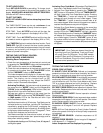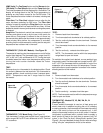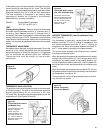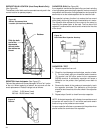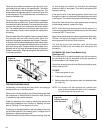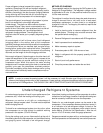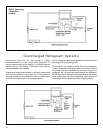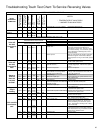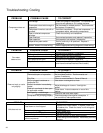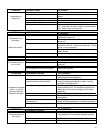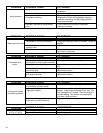
31
NOTE: In order to access the sealed system it will be necessary to install Schrader type fittings to the process
tubes on the discharge and suction of the compressor. Proper recovery refrigerant procedures need to be adhered
to as outlined in EPA Regulations. THIS SHOULD ONLY BE ATTEMPTED BY QUALIFIED SERVICE PERSONNEL.
An undercharged system will result in poor performance (low
pressures, etc.) in both the heating and cooling cycle.
Whenever you service a unit with an undercharge of
refrigerant, always suspect a leak. The leak must be repaired
before charging the unit.
To check for an undercharged system, turn the unit on, allow
the compressor to run long enough to establish working
pressures in the system (15 to 20 minutes).
During the cooling cycle you can listen carefully at the exit of
the metering device into the evaporator; an intermittent hissing
and gurgling sound indicates a low refrigerant charge.
Intermittent frosting and thawing of the evaporator is another
indication of a low charge, however, frosting and thawing can
also be caused by insufficient air over the evaporator.
Checks for an undercharged system can be made at the
compressor . If the compressor seems quieter than normal, it
is an indication of a low refrigerant charge. A check of the
amperage drawn by the compressor motor should show a
lower reading. (Check the Unit Specification.) After the unit
has run 10 to 15 minutes, check the gauge pressures.
Gauges connected to system with an undercharge will have
low head pressures and substantially low suction pressures.
Undercharged Refrigerant Systems
Proper refrigerant charge is essential to proper unit
operation. Operating a unit with an improper refrigerant
charge will result in reduced performance (capacity) and/or
efficiency. Accordingly, the use of proper charging methods
during servicing will insure that the unit is functioning as
designed and that its compressor will not be damaged.
Too much refrigerant (overcharge) in the system is just as
bad (if not worse) than not enough refrigerant
(undercharge). They both can be the source of certain
compressor failures if they remain uncorrected for any
period of time. Quite often, other problems (such as low air
flow across evaporator, etc.) are misdiagnosed as
refrigerant charge problems. The refrigerant circuit
diagnosis chart will assist you in properly diagnosing these
systems.
An overcharged unit will at times return liquid refrigerant
(slugging) back to the suction side of the compressor
eventually causing a mechanical failure within the compressor.
This mechanical failure can manifest itself as valve failure,
bearing failure, and/or other mechanical failure. The specific
type of failure will be influenced by the amount of liquid being
returned, and the length of time the slugging continues.
Not enough refrigerant (Undercharge) on the other hand, will
cause the temperature of the suction gas to increase to the
point where it does not provide sufficient cooling for the
compressor motor. When this occurs, the motor winding
temperature will increase causing the motor to overheat and
possibly cycle open the compressor overload protector.
Continued overheating of the motor windings and/or cycling
of the overload will eventually lead to compressor motor or
overload failure.
METHOD OF CHARGING
The acceptable method for charging the RAC system is the
Weighed in Charge Method. The weighed in charge method
is applicable to all units. It is the preferred method to use, as
it is the most accurate.
The weighed in method should always be used whenever a
charge is removed from a unit such as for a leak repair,
compressor replacement, or when there is no refrigerant
charge left in the unit. To charge by this method, requires the
following steps:
1. Install a piercing valve to remove refrigerant from the
sealed system. (Piercing valve must be removed from
the system before recharging.)
2. Recover Refrigerant in accordance with EPA regulations.
3. Install a process tube to sealed system.
4. Make necessary repairs to system.
5. Evacuate system to 250 - 300 microns or less.
6. Weigh in refrigerant with the property quantity of R-22
refrigerant.
7. Start unit, and verify performance.
8. Crimp the process tube and solder the end shut.



